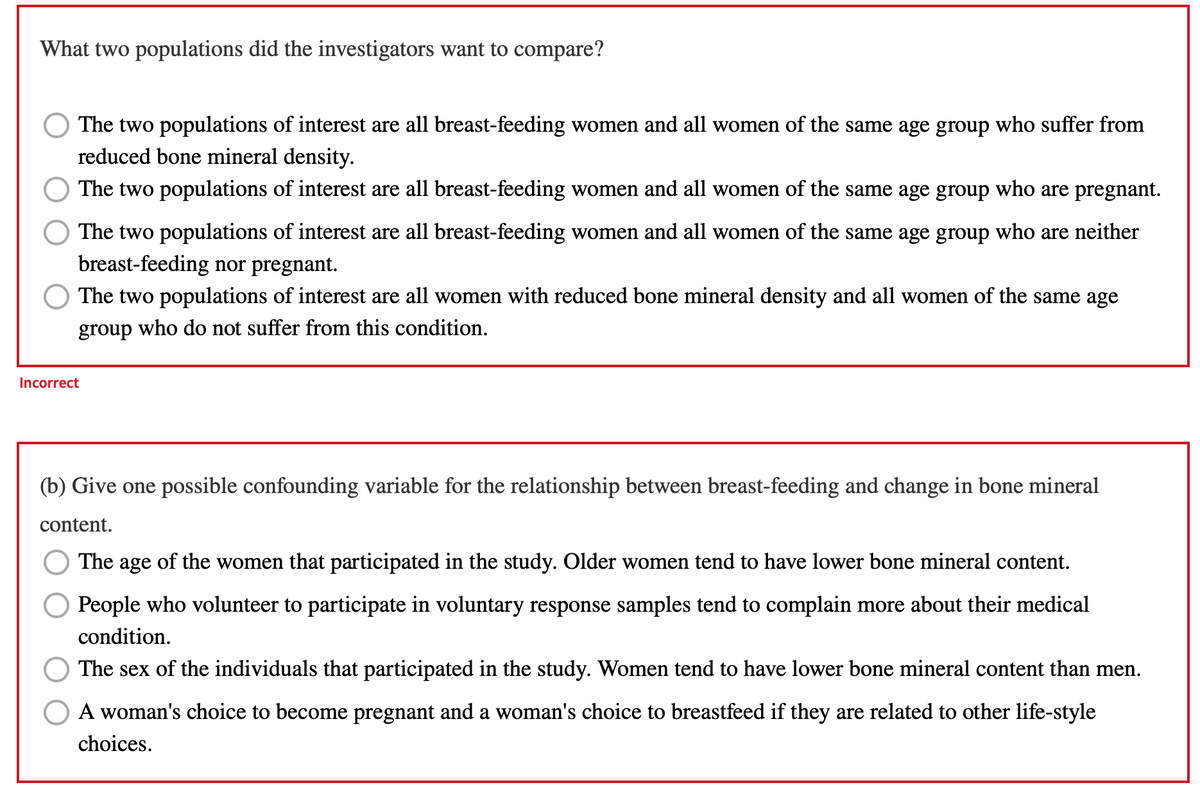What two populations did the investigators want to compare? The two populations of interest are all breast-feeding women and all women of the same age group who suffer from reduced bone mineral density. The two populations of interest are all breast-feeding women and all women of the same age group who are pregnant. The two populations of interest are all breast-feeding women and all women of the same age group who are neither breast-feeding nor pregnant. The two populations of interest are all women with reduced bone mineral density and all women of the same age group who do not suffer from this condition. correct (b) Give one possible confounding variable for the relationship between breast-feeding and change in bone mineral content. The age of the women that participated in the study. Older women tend to have lower bone mineral content. People who volunteer to participate in voluntary response samples tend to complain more about their medical condition. The sex of the individuals that participated in the study. Women tend to have lower bone mineral content than men. A woman's choice to become pregnant and a woman's choice to breastfeed if they are related to other life-style choices. O O O O
What two populations did the investigators want to compare? The two populations of interest are all breast-feeding women and all women of the same age group who suffer from reduced bone mineral density. The two populations of interest are all breast-feeding women and all women of the same age group who are pregnant. The two populations of interest are all breast-feeding women and all women of the same age group who are neither breast-feeding nor pregnant. The two populations of interest are all women with reduced bone mineral density and all women of the same age group who do not suffer from this condition. correct (b) Give one possible confounding variable for the relationship between breast-feeding and change in bone mineral content. The age of the women that participated in the study. Older women tend to have lower bone mineral content. People who volunteer to participate in voluntary response samples tend to complain more about their medical condition. The sex of the individuals that participated in the study. Women tend to have lower bone mineral content than men. A woman's choice to become pregnant and a woman's choice to breastfeed if they are related to other life-style choices. O O O O
Chapter6: Systems Of Equations And Inequalities
Section: Chapter Questions
Problem 17PS: Cholesterol Cholesterol in human blood is necessary, but too much can lead to health problems. There...
Related questions
Question
Breast‑feeding mothers secrete calcium into their milk. Some of the calcium may come from their bones, resulting in reduced bone mineral density. Researchers compared 47 breast‑feeding women with 22 women of similar age who were neither pregnant nor lactating. They measured the percent change in the mineral content of the women's spines over three months.

Transcribed Image Text:What two populations did the investigators want to compare?
The two populations of interest are all breast-feeding women and all women of the same age group who suffer from
reduced bone mineral density.
O The two populations of interest are all breast-feeding women and all women of the same age group who are pregnant.
The two populations of interest are all breast-feeding women and all women of the same age group who are neither
breast-feeding nor pregnant.
The two populations of interest are all women with reduced bone mineral density and all women of the same age
group who do not suffer from this condition.
Incorrect
(b) Give one possible confounding variable for the relationship between breast-feeding and change in bone mineral
content.
The age of the women that participated in the study. Older women tend to have lower bone mineral content.
People who volunteer to participate in voluntary response samples tend to complain more about their medical
condition.
The sex of the individuals that participated in the study. Women tend to have lower bone mineral content than men.
A woman's choice to become pregnant and a woman's choice to breastfeed if they are related to other life-style
choices.
Expert Solution
This question has been solved!
Explore an expertly crafted, step-by-step solution for a thorough understanding of key concepts.
This is a popular solution!
Trending now
This is a popular solution!
Step by step
Solved in 2 steps

Knowledge Booster
Learn more about
Need a deep-dive on the concept behind this application? Look no further. Learn more about this topic, statistics and related others by exploring similar questions and additional content below.Recommended textbooks for you


Linear Algebra: A Modern Introduction
Algebra
ISBN:
9781285463247
Author:
David Poole
Publisher:
Cengage Learning

Algebra & Trigonometry with Analytic Geometry
Algebra
ISBN:
9781133382119
Author:
Swokowski
Publisher:
Cengage


Linear Algebra: A Modern Introduction
Algebra
ISBN:
9781285463247
Author:
David Poole
Publisher:
Cengage Learning

Algebra & Trigonometry with Analytic Geometry
Algebra
ISBN:
9781133382119
Author:
Swokowski
Publisher:
Cengage

Trigonometry (MindTap Course List)
Trigonometry
ISBN:
9781337278461
Author:
Ron Larson
Publisher:
Cengage Learning